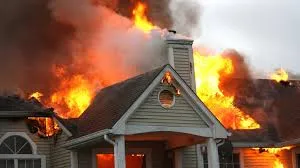Experiencing a fire in your home can be one of the most traumatic events imaginable. The immediate aftermath often leaves homeowners feeling overwhelmed and unsure of where to begin.
But don’t worry, this guide will walk you through the essential steps for effective fire damage restoration, helping you regain control and start the recovery process with confidence.
Step 1: Ensure Safety First
Before you do anything, make sure your home is safe to enter. Fires can leave structures unstable, with hidden hazards such as weakened floors or walls that could collapse. Here’s what you need to do:
- Wait for the All-Clear: Only enter your home after the fire department has deemed it safe. They will assess the structural integrity and potential hazards.
- Protective Gear: Wear protective clothing, including gloves, masks, and sturdy shoes. There may be lingering smoke, soot, and potentially harmful chemicals.
- Avoid Electrical Hazards: Do not turn on any electrical appliances or systems until they have been inspected by a professional. Fire can damage wiring, creating a risk of electric shock or further fire.
Safety should always be your first priority. Once you’ve ensured that it’s safe to proceed, you can move on to the next steps.
Step 2: Contact Your Insurance Company
One of the first calls you should make is to your insurance company. They need to be informed of the fire as soon as possible to start the claims process. Here’s how to navigate this step:
- Document the Damage: Take comprehensive photos and videos of all affected areas and items. This will be crucial for your insurance claim.
- List Your Belongings: Make an inventory of damaged items. Include as much detail as possible, such as make, model, and estimated value.
- Keep Receipts: Save any receipts for expenses related to the fire, such as temporary housing, meals, and cleaning supplies. These may be reimbursable.
Your insurance company will guide you through their process, but keeping detailed records will make your claim easier and help you get the compensation you need.
Step 3: Assess the Damage
Once you’ve contacted your insurance company, it’s time to assess the extent of the damage. This will help you understand the scope of the restoration work required. Here’s what to look for:
- Structural Damage: Check for any signs of structural weakness, such as cracks in walls, ceilings, or foundations.
- Water Damage: Firefighting efforts often involve a lot of water, which can cause significant water damage. Look for signs of water intrusion, such as damp walls, ceilings, and floors.
- Soot and Smoke Damage: Soot and smoke can permeate everything, from walls and furniture to clothing and personal items. They not only cause discoloration but can also leave lingering odors and harmful residues.
- Hidden Damage: Sometimes, damage isn’t immediately visible. Professional restoration companies use specialized equipment to detect issues behind walls and under floors.
A thorough assessment will help you understand what needs to be repaired, replaced, or cleaned.
Step 4: Begin the Cleaning Process
The cleaning process is a critical step in fire damage restoration. It’s essential to address both visible and hidden damage to restore your home to a livable condition. Here’s a breakdown of the cleaning tasks:
- Remove Debris: Start by removing any debris and damaged items. This will give you a clearer view of the underlying issues.
- Soot and Smoke Removal: Clean all surfaces to remove soot and smoke residues. Use specialized cleaning products and techniques, as regular household cleaners might not be effective.
- Odor Removal: Smoke odors can linger long after the fire is out. Use air purifiers, deodorizing sprays, and professional-grade equipment to eliminate these odors. Sometimes, thermal fogging or ozone treatments are necessary for stubborn smells.
- Water Removal and Drying: If there was significant water used to extinguish the fire, you’ll need to dry out your home thoroughly. This may involve dehumidifiers, fans, and professional water extraction services.
- Disinfect and Sanitize: Fire and water can bring in harmful bacteria and mold. Disinfecting and sanitizing affected areas will help ensure your home is safe and healthy to live in.
Cleaning up after a fire is a daunting task, but thoroughness is key to preventing further damage and health issues.
Step 5: Restore and Rebuild
The final step is to restore and rebuild your home. This is where you begin to see the light at the end of the tunnel as your home starts to look like itself again. Here’s what to focus on:
- Structural Repairs: Fix any structural damage identified during your assessment. This may involve reinforcing walls, repairing roofs, or replacing damaged flooring.
- Electrical and Plumbing: Ensure all electrical and plumbing systems are inspected and repaired by licensed professionals. Fire can cause hidden damage that isn’t always immediately apparent.
- Interior Restoration: Repaint walls, replace flooring, and restore furniture. It’s also a good time to consider upgrading materials and finishes if your budget allows.
- Personal Belongings: Restore or replace personal items. Some items may need professional cleaning, such as clothing, upholstery, and electronics.
- Final Inspection: Before you fully move back in, conduct a final inspection to ensure all repairs are completed to your satisfaction and that your home is safe.
Restoring and rebuilding can take time, but each step brings you closer to returning to normalcy.
Dealing with the aftermath of a fire is never easy, but following these essential steps can make the restoration process more manageable. For professional assistance and peace of mind, consider reaching out to experts in the field.
The United Water Restoration Group specializes in fire damage restoration, providing comprehensive services to help you get your home back to its best condition. They understand the emotional and practical challenges homeowners face and are dedicated to delivering efficient, high-quality restoration services.
For more information or to schedule a consultation, visit the United Water Restoration Group website or give them a call at 704-228-8888. Let the professionals handle the hard work, so you can focus on moving forward.






